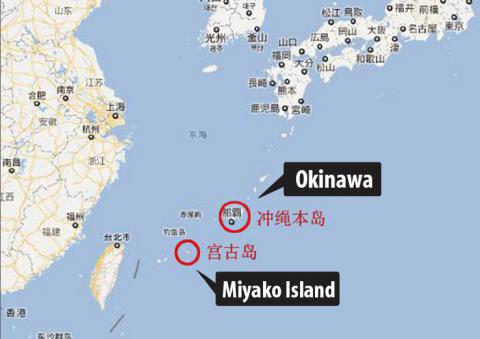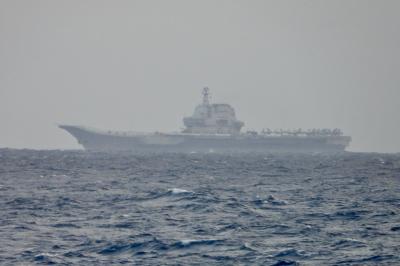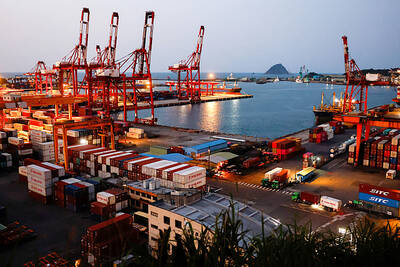Sorties by the Chinese navy into the Pacific Ocean are becoming more commonplace and provide it with the means to familiarize itself with the environment surrounding Taiwan, while creating a new front from which to attack in case of conflict, an analyst said.
Four frigates from the People’s Liberation Army Navy (PLAN) were spotted in waters between Miyako Island and Okinawa Island on Friday, the Japanese Ministry of Defense said last week. All four ships, which were tracked by a P-3C patrol aircraft deployed by the Japan Maritime Self-Defense Forces, were traveling from the direction of the East China Sea toward the Pacific Ocean, where they conducted exercises.
The ships — the Type 054A Jiangkai II-class missile frigate Changzhou, the Jiangwei II-class Jiangxing and Lianyungang and the Jiangwei I-class Tongling — stayed in international waters and did not enter Japanese territorial waters, the ministry said.

Source: screengrab from Google Map
All the ships, which are part of China’s East Sea Fleet, are equipped with anti-ship and surface-to-air missiles.
The 300km-wide channel between Okinawa and Miyako, known as the Miyako Strait, is regarded as one of the most convenient routes for Chinese vessels heading for the Pacific. Chinese vessels went through it in June 2010 and twice last year as they headed for exercises in the Pacific.
Such sorties have become increasingly commonplace as China’s navy gets more comfortable as an oceangoing navy, James Holmes, an associate professor at the US Naval War College, told the Taipei Times.
Holmes, who recently co-authored a study of the Chinese navy, said the Japanese Defense Ministry was now publishing maps of Chinese naval forays through the Japanese archipelago.
“The maps depict the tracks of PLAN flotillas as though ramen noodles were spilling through the home islands into the Pacific,” he said, adding that in peacetime, China had as much a right as anyone to transit through those waterways, provided they conformed to the restrictions in the Law of the Sea Treaty.
However, asked to discuss the implications for Taiwan’s security, Holmes was less sanguine.
“I have no doubt that the PLAN is familiarizing itself with the operating environment off Taiwan, including the coastal geography and underwater hydrography, and experimenting with tactics for waging war there,” he said.
“Some strategists, myself included, portray [Taiwan’s] rugged eastern coast as a kind of sanctuary for small missile boats and, potentially, submarines,” Holmes said. “It only makes sense for the PLAN to take the measure of the ‘strength and situation’ of a potential enemy before an armed clash.”
Crucially, the PLAN presence in the Pacific enhances its ability to fight all around Taiwan and not just along the west coast, which has been the traditional direction from which a Chinese attack would come, he said.
Miyako is located about 350km east off the northern tip of Taiwan, including Keelung Naval Base. The area also faces Cha Shan Air Base in Hualien.
Such encirclement of Taiwan would greatly complicate its ability to counter a naval attack and could exploit weaknesses in defenses along its east coast, which faces away from China.
“Equally important, by displaying that capability vis-a-vis Taipei and Washington, the navy enhances Beijing’s bargaining power in future dealings across the strait,” Holmes said. The PLA Navy is practicing the skills needed to coerce and deter while helping underwrite Chinese diplomacy in the bargain.”
In related developments, the People’s Liberation Army Daily announced on Tuesday that the recently commissioned Type 071 Jinggangshan landing platform dock under the South China Sea Fleet had conducted its first joint training with helicopters and air cushion boats. At 19,000 tonnes, the Jinggangshan is the heaviest LPD in the PLAN.

US President Donald Trump yesterday announced sweeping "reciprocal tariffs" on US trading partners, including a 32 percent tax on goods from Taiwan that is set to take effect on Wednesday. At a Rose Garden event, Trump declared a 10 percent baseline tax on imports from all countries, with the White House saying it would take effect on Saturday. Countries with larger trade surpluses with the US would face higher duties beginning on Wednesday, including Taiwan (32 percent), China (34 percent), Japan (24 percent), South Korea (25 percent), Vietnam (46 percent) and Thailand (36 percent). Canada and Mexico, the two largest US trading

AIR SUPPORT: The Ministry of National Defense thanked the US for the delivery, adding that it was an indicator of the White House’s commitment to the Taiwan Relations Act Deputy Minister of National Defense Po Horng-huei (柏鴻輝) and Representative to the US Alexander Yui on Friday attended a delivery ceremony for the first of Taiwan’s long-awaited 66 F-16C/D Block 70 jets at a Lockheed Martin Corp factory in Greenville, South Carolina. “We are so proud to be the global home of the F-16 and to support Taiwan’s air defense capabilities,” US Representative William Timmons wrote on X, alongside a photograph of Taiwanese and US officials at the event. The F-16C/D Block 70 jets Taiwan ordered have the same capabilities as aircraft that had been upgraded to F-16Vs. The batch of Lockheed Martin

China's military today said it began joint army, navy and rocket force exercises around Taiwan to "serve as a stern warning and powerful deterrent against Taiwanese independence," calling President William Lai (賴清德) a "parasite." The exercises come after Lai called Beijing a "foreign hostile force" last month. More than 10 Chinese military ships approached close to Taiwan's 24 nautical mile (44.4km) contiguous zone this morning and Taiwan sent its own warships to respond, two senior Taiwanese officials said. Taiwan has not yet detected any live fire by the Chinese military so far, one of the officials said. The drills took place after US Secretary

CHIP EXCEPTION: An official said that an exception for Taiwanese semiconductors would have a limited effect, as most are packaged in third nations before being sold The Executive Yuan yesterday decried US President Donald Trump’s 32 percent tariff on Taiwanese goods announced hours earlier as “unfair,” saying it would lodge a representation with Washington. The Cabinet in a statement described the pledged US tariffs, expected to take effect on Wednesday next week, as “deeply unreasonable” and “highly regrettable.” Cabinet spokeswoman Michelle Lee (李慧芝) said that the government would “lodge a solemn representation” with the US Trade Representative and continue negotiating with Washington to “ensure the interests of our nation and industries.” Trump at a news conference in Washington on Wednesday announced a 10 percent baseline tariff on most goods